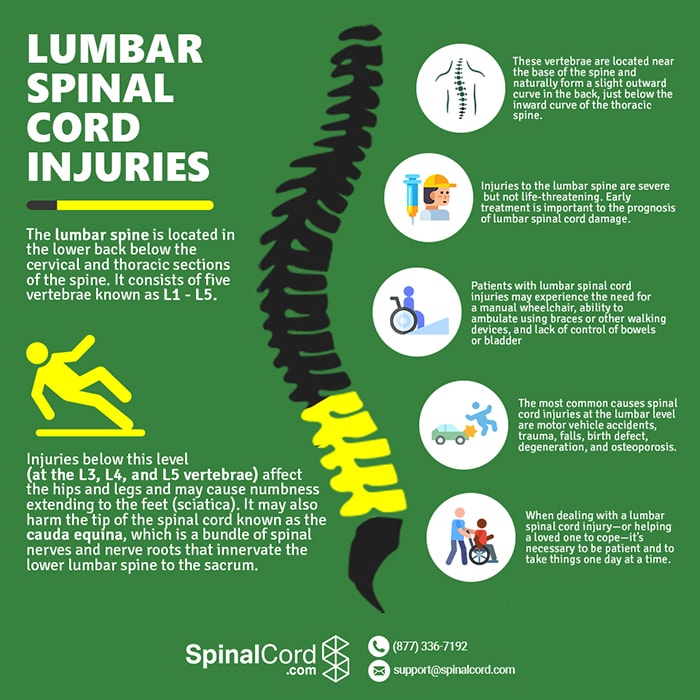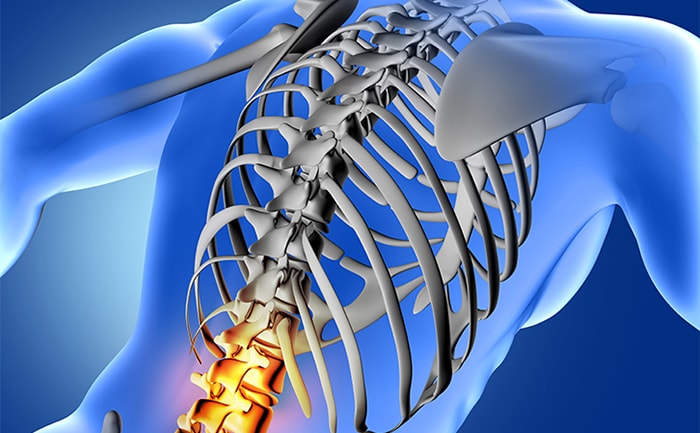Lumbar (L1-L5) Spinal Cord Injuries
Injuries to the lumbar spine are severe but not life-threatening. Early treatment
is important to the prognosis.

Injuries to the lumbar spine are severe but not life-threatening. Early treatment
is important to the prognosis.
Injuries to the lumbar spine are severe but not life-threatening. Early treatment is important to the prognosis.
The lumbar spine is located in the lower back below the cervical and thoracic sections of the spine. It consists of five vertebrae known as L1 - L5. These lumbar vertebrae (or lumbar bones) contain spinal cord tissue and nerves which control communication between the brain and the legs. Damage to the lumbar spinal cord subsequently affects the hips and groin area, and may impact the lower abdominal muscles and thigh flexion as well.
Lumbar spinal cord injuries (SCIs) may be complete or incomplete and may affect one or both sides of the body. As is the case with other spinal cord injuries, the completeness of the spinal cord damage will determine how severe the injury and symptoms will be for the patient.
It is also important to understand that the lumbar vertebrae are much different than the upper segments of the spine because the spinal cord does not extend the entire length of the lumbar spine. L2 is the lowest vertebral segment that contains spinal cord tissue. After that point, nerve roots exit each of the remaining lumbar levels beyond the spinal cord.
Injuries below this level (at the L3, L4, and L5 vertebrae) affect the hips and legs and may cause numbness extending to the feet (sciatica). It may also harm the tip of the spinal cord known as the cauda equina, which is a bundle of spinal nerves and nerve roots that innervate the lower lumbar spine to the sacrum.
As a fetus, vertebral segments directly relate to spinal cord segments. As an adult, the spinal column grows longer than the spinal cord and they no longer relate to one another. The spinal cord ends around the L1 or L2 vertebrae in adults, forming the conus medullaris. The horsetail shaped area, which extends past the conus medullaris, is called the cauda equina.
How many vertebrae are in the spine? Well, for the lumbar spinal column, there are five sections.
Lumbar vertebrae anatomy is generally classified by dividing the lumbar spine into five distinct sections. These sections are labelled as the L1-L5 vertebrae. These vertebrae are located near the base of the spine and naturally form a slight outward curve in the back, just below the inward curve of the thoracic spine. The lumbar vertebrae function to contain and protect the end of the spinal cord, as well as support the weight of the torso.
Here’s a quick explanation of how the lumbar spinal cord fits in with your lower back anatomy, as well as potential symptoms of injuries do different parts of the lumbar spine.
The L1 vertebra is the topmost section of the lumbar spinal column. This section of the spine contains a portion of the spinal cord. Injuries to the L1 spine can affect hip flexion, cause paraplegia, loss of bowel/bladder control, and/or numbness in the legs.
The L2 vertebra contains the end of the spinal cord proper—all other spinal vertebrae below this point only have spinal nerves, not the spinal cord. Injuries to the L2 vertebra can have effects similar to an L1 injury (reduced hip flexion, paraplegia, and numbness).
This is the middle vertebra of the lumbar spine, and the first vertebra to not contain a section of the spinal cord. Common symptoms of an L3 lumbar spinal injury include weakness, numbness, and loss of flexibility in the legs, hips, and/or groin.
The second to last section of the lumbar spinal column. While injuries to the L4 vertebra tend to be less severe than injuries to the spinal cord proper, symptoms include an inability to bend the feet in a particular direction.
The L5 vertebra is the final section of the lumbar spine (at least, it is for most people). Injury to the L5 spinal nerve bundle can cause numbness and weakness in the legs, but the extent of these symptoms can vary from case to case.


While most people have only five lumbar vertebrae, there are cases where someone could have an extra lumbar vertebra. This is called lumbarization. It is usually the result of the first and second parts of the sacrum failing to fuse, creating an extra bone in the spinal column.
In the majority of cases, this condition is harmless. However, some people who live with lumbarization may experience lower back pain without knowing why, or may be more prone to herniated discs in their spine.
Injuries to the lumbar spine are severe but not life-threatening. Early treatment is important to the prognosis of lumbar spinal cord damage. Patients with a lumbar spinal cord injury can be independent and care for their own mobility and hygienic needs. Many patients are able to maneuver around in their manual wheelchair and may even be able to walk for short distances. Weakness is the main issue with patients who experience lumbar nerve injuries, so physical therapy is a must in the recovery phase.
Cauda Equina Syndrome (CES), which is often difficult to distinguish from the similarly-located conus medullaris syndrome, affects the lumbar spine and is considered a medical emergency. CES affects the nerves of the lumbar spine, which may cause incontinence and potentially permanent paralysis of the legs. Patient’s symptoms may come on slowly, but once it is diagnosed, it requires immediate surgery.
*Learn more about Cauda Equina Syndrome or Conus Medullaris Syndrome.
Patients with lumbar spinal cord injuries may experience:
The most common causes spinal cord injuries at the lumbar level are:
There are several types of spinal cord injury that can affect the lumbar spine:
Where lumbarization is the presence of an extra bone in the lumbar spinal column due to the failure of the first and second sacral spine to fuse, sacralization is the fusing of the L5 vertebra with the sacral spine.
This condition frequently has no noticeable symptoms. In fact, people can live their whole lives without realizing that they have sacralization of their L5 vertebra. When symptoms do occur, they often include arthritis, reduced range of motion (because of the fused bone), and/or pain in the legs or buttocks.
Generally speaking, sacralization is very mild. But, it can exacerbate other spinal cord injury types.
Some spinal injuries can cause cysts to develop inside the spinal column. These fluid-filled sacs can put pressure on spinal nerves—causing pain, loss of sensation, or loss of function at the injury site.
Hopkinsmedicine.org notes that the “joints in the lumbar region” of the spine are particularly susceptible to developing spinal cysts. These cysts are most often caused by repetitive motion stress injuries (i.e. carpal tunnel syndrome). Such cysts can be identified using magnetic resonance imaging (MRI) scans, but most doctors will probably start with an X-ray to rule out other conditions, such as spinal fractures.
When the vertebrae protecting the spinal cord and spinal nerves are fractured or dislocated, bone shards can damage or pinch the spinal nerves/cord. These fractures are most often the result of traumatic force—such as falls, gunshots, or physical blows—being applied to the spine.
Fractures carry a high risk of causing complete spinal cord injuries—preventing any signals from the central nervous system from reaching below the injury site. As such, all fractures should be handled with extreme caution to prevent worsening a lumbar SCI.
Current treatments available for spinal cord patients with lumbar injuries include:
It’s important to know that not every spinal cord injury and treatment will affect a person’s lumbar vertebrae anatomy in the same way. In some cases, treatment may not produce any noticeable improvement in lumbar SCI symptoms. Meanwhile, another person undergoing the same exact combination of drugs, surgery, and therapy might see marked improvement.
When dealing with a lumbar spinal cord injury—or helping a loved one to cope—it’s necessary to be patient and to take things one day at a time.
It can also help to look for SCI support groups. These groups are filled with people who have been in the same situations and overcome them—and may have great advice for helping you do the same. They can help recommend mobility assistance solutions, exercise regimens, and more that can help people living with lumbar SCIs lead healthy, active, and fulfilling lives.
Spinal cord injuries are traumatic for patients and their families. They cause disruptive changes to every aspect of your life and there is a lot of new information to navigate and understand. Our experts have collected everything in one place to help you learn more about your injury, locate doctors and treatment centers, find financial support, and get assistance navigating your next move.
Sponsored by Tampa personal injury lawyers at Swope, Rodante P.A. a Florida law firm located at 1234 E 5th Ave, Tampa, FL 33605.
The information provided by SpinalCord.com is not a substitute for professional medical advice, diagnosis, or treatment, see Disclaimer Policy.